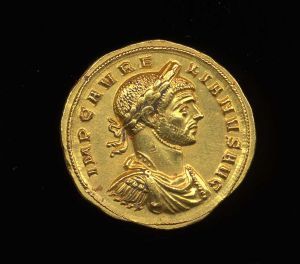Server check!
You are on the training database
Aurelian
Reece Period attributed: Period 13

Member of the Third Century Emperors dynasty.
Coins for this issuer were issued from 270 until 275.
Lucius Domitius Aurelianus was born ca. 214 in Moesia Inferior (a Danube province). He led a military career and achieved honours under Gallienus; he may have instigated the plot which led to the murder of that emperor. Aurelian did not succeed Gallienus, but allowed the more popular Claudius II to rule.
When Claudius II died of the Plague, Aurelian became the natural choice for a successor. He went to Rome for the winter, but then went back to the Danube to face the threats of various tribes along the border. Recurring invasions by Germanic groups made Aurelian decide that Rome, unwalled since the reign of Augustus, needed a city wall. He accordingly built the Aurelian Wall (finished by Probus).
Probus, Aurelian’s chief general and future successor, reconquered Egypt; Aurelian re-took the separatist Gallic Empire. He celebrated a huge victory in Rome and set off to fight the Persians. On the way, he fell victim to a misunderstanding—his men thought they were sentenced to punishment and revolted, when in reality the rumor was spread by the emperor’s secretary to escape his own punishment. After only five years this beloved and successful emperor died; the Senate immediately deified him and his soldiers gave him a magnificent burial.
Other resources about Aurelian
- Dbpedia: http://dbpedia.org/resource/Aurelian
- Wikipedia: http://en.wikipedia.org/wiki/Aurelian
- VIAF: http://viaf.org/viaf/77109448
View all coins recorded by the scheme attributed to Aurelian.
Information from Wikipedia

- Preferred label: Aurelian
- Full names:
- Aurelian
- List of Roman emperors
- List of Roman consuls
- Roman consul
- Titus Flavius Postumius Quietus
- Aemilianus II
- M. Claudius Tacitus II
- Junius Veldumnianus
- Tacitus (emperor)
- Virius Orfitus
- Flavius Antiochianus
- Placidianus
- 214 births
- Gothicus Maximus
- People from Sirmium
- 275 deaths
- Aurelian
- Domitii
- 210s births
- Roman emperors murdered by the Praetorian Guard
- Assassinated heads of state
- Roman emperors to suffer posthumous denigration or damnatio memoriae
- Illyrian people
- 3rd-century Roman emperors
- Crisis of the Third Century
- 3rd-century murdered monarchs
- Deified Roman emperors
- 3rd-century Romans
- Imperial Roman consuls
- Illyrian emperors
Denominations issued
- As - view all records of this denomination issued by Aurelian
- Aureus (Republic/Empire) - view all records of this denomination issued by Aurelian
- Denarius (Empire) - view all records of this denomination issued by Aurelian
- Dupondius - view all records of this denomination issued by Aurelian
- Sestertius - view all records of this denomination issued by Aurelian
- Semis - view all records of this denomination issued by Aurelian
- Dupondius or as - view all records of this denomination issued by Aurelian
- Quadrans - view all records of this denomination issued by Aurelian
- Quinarius - view all records of this denomination issued by Aurelian
- Radiate (antoninianus) - view all records of this denomination issued by Aurelian
- Medallion - view all records of this denomination issued by Aurelian
Issuing mints
This video has been embedded from Adrian Murdoch's series of podcasts on the Emperors of Rome. Many thanks to him for allowing us to use these podcasts.


